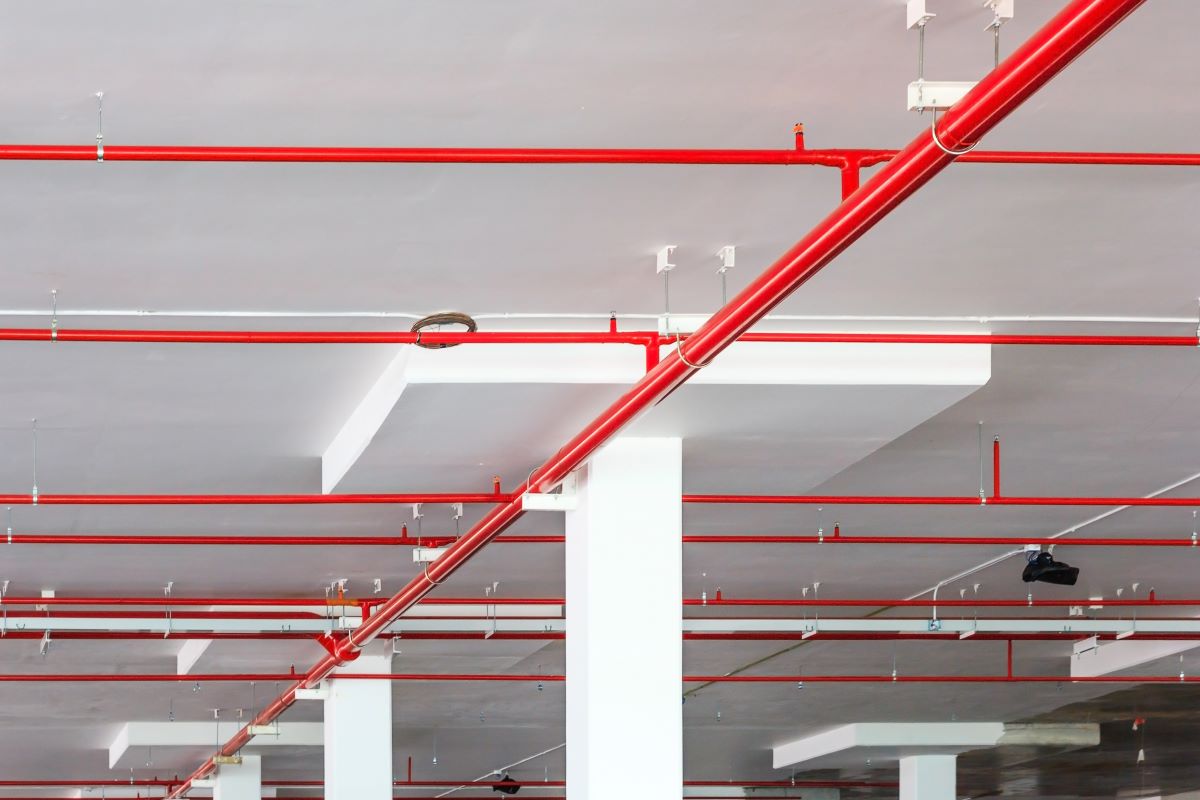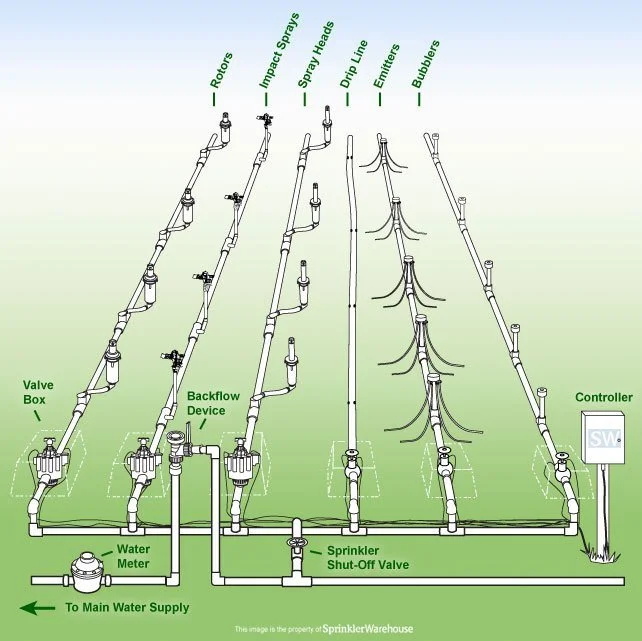Discovering one of the most Common Problems in Sprinkler Equipments and Their Repairs
Lawn sprinkler are crucial for preserving healthy landscapes, yet they frequently encounter various problems. Typical problems include stopped up nozzles, damaged pipes, and unequal watering patterns. Each of these can considerably impact system performance and water effectiveness. Recognizing these troubles and their services is crucial for any property owner. The complying with sections will certainly lay out typical difficulties and the needed fixings to keep a lawn sprinkler functioning at its finest. What comes next may surprise those unprepared for upkeep realities.
Clogged Nozzles and Lawn Sprinkler Heads
Stopped up nozzles and lawn sprinkler heads prevail issues that can considerably impede the efficiency of an automatic sprinkler. Gradually, particles such as mineral, dirt, and algae accumulation can collect, blocking water circulation and causing unequal coverage in the yard or garden. This can lead to specific areas receiving insufficient water, while others might come to be over-saturated.
Normal upkeep is vital to stop these blockages. Routine checks can identify any clogs, and cleaning can typically be accomplished with simple devices like a tiny brush or a toothpick. Sometimes, soaking clogged parts in vinegar can assist liquify mineral down payments.
For severe blockages, substitute of the nozzle or head may be necessary to recover appropriate function. Addressing these issues promptly ensures that the sprinkler system runs effectively, maintaining a healthy and balanced landscape and enhancing water use.
Broken Pipeline and Leaks
Broken pipelines and leaks can greatly interrupt the functionality of an automatic sprinkler. Identifying pipeline damage very early is important to stop further issues, and comprehending repair work techniques can simplify the process. In addition, executing preventative upkeep suggestions can aid guarantee the durability of the system and reduce the probability of future problems.
Determining Pipeline Damages
How can house owners effectively determine pipeline damage in their lawn sprinkler? To begin, they should routinely evaluate their yards for unusual damp places or pooling water, which may suggest a leakage. Additionally, house owners can check their water costs for unexplained boosts, recommending surprise leakages within the system. Observing the sprinkler heads for uneven spray patterns or not enough protection can also indicate prospective pipeline issues. Paying attention for unusual sounds, such as gurgling or hissing, might show air running away from harmed pipelines. Performing aesthetic examinations of revealed pipelines for cracks or corrosion can aid determine troubles. By utilizing these techniques, house owners can proactively find and resolve pipe damages in their automatic sprinkler prior to it causes much more significant issues.
Repair Techniques Review
Addressing pipeline damages in a sprinkler system requires a systematic strategy to repair services, especially when dealing with breaks and leakages. The initial step frequently involves situating the damaged location, which can be accomplished through aesthetic assessment or pressure testing. As soon as determined, the repair work technique might vary; for tiny leaks, making use of pipeline sealant or epoxy can efficiently secure the afflicted section. In instances of significant breaks, removing the damaged pipeline section and changing it with new piping, protected with appropriate adapters, is recommended. In addition, guaranteeing correct positioning and safeguarding joints will aid avoid future concerns. After repair work, detailed testing of the system is necessary to verify that leakages have been dealt with and that the system operates successfully.
Preventative Maintenance Tips
To lessen the risk of damaged pipelines and leakages in an automatic sprinkler, normal preventative upkeep is vital. Property owners need to routinely check the system for noticeable damages, guaranteeing that pipelines and installations are intact. Seasonal modifications are necessary; before winter season, systems must be drained pipes to stop freezing, while spring checks can determine wear from frost or shifting soil. In addition, maintaining the location around sprinkler heads clear of debris assists prevent obstructions that can cause leakages. Routinely testing water pressure can expose underlying problems, as extreme pressure may strain pipes. Recording upkeep tasks can assist track performance and identify repeating problems, making it simpler to address any problems proactively.
Uneven Watering Patterns
Unequal watering patterns can result in irregular lawns and stressed plants, coming from different causes such as blocked nozzles or misaligned sprinkler heads. Recognizing these concerns is necessary for efficient repair work and guaranteeing consistent water circulation across the landscape. Solutions might entail basic maintenance jobs or modifications to the lawn sprinkler for perfect efficiency.
Reasons of Uneven Watering
When a lawn sprinkler system falls short to disperse water evenly throughout a yard, several aspects may add to this problem. One common reason is incorrect sprinkler head positioning, which can result in overlapping or not enough protection. Additionally, stopped up nozzles can restrict water circulation, resulting in completely dry spots. Variations in water stress can also affect distribution, as some locations might get extra water than others. Additionally, uneven surface or soil compaction can influence exactly how water passes through the ground, resulting in irregular absorption. The age of the lawn sprinkler components might result in decreased efficiency, contributing to inconsistent watering patterns. Determining these reasons is crucial for preserving a reliable automatic sprinkler and making sure a healthy and balanced lawn.
Solutions for Repairing Issues
Attending to irregular watering patterns requires a methodical technique to identify and rectify underlying problems. Checking lawn sprinkler heads for blockages or damages is essential; cleansing or changing them can boost water circulation. Next, adjusting the automatic sprinkler's stress setups might aid attain an extra consistent spray. In addition, evaluating the layout of the sprinklers can expose areas that need rearranging to guarantee protection consistency. Looking for leaks in fittings or pipes is crucial, as leaks can bring about irregular watering. Ultimately, setting the timer to suit various zones based on plant requirements can improve overall efficiency. By applying these solutions, one can properly bring back balanced watering patterns within the landscape.
Timer and Control Issues
A well-functioning timer is essential for peak sprinkler system efficiency, numerous homeowners run into problems that disrupt their irrigation schedules. Typical troubles include faulty programming, where timers website may not mirror the designated watering times, leading to over- or under-watering. In addition, power failures can reset timers, creating them to return to default settings and neglecting the personalized schedules homeowners rely on. Malfunctions can additionally stem from out-of-date technology; older timers may do not have the features needed for maximum control, such as rain sensors or wise technology combination. Circuitry problems can protect against signals from reaching the valves, making the system unusable. Regular maintenance and timely updates can aid reduce these problems. Home owners should consider seeking advice from specialists for troubleshooting to guarantee their timers operate effectively and efficiently, as appropriate control is vital for preserving and preserving a healthy and balanced landscape water sources
Lawn Sprinkler System Stress Problems
How can inadequate water pressure impact an automatic sprinkler's efficiency? Inadequate water stress can cause unequal water circulation, causing completely dry spots and overwatered locations. This incongruity endangers the total wellness of the landscape, as plants might deal with either dry spell stress and anxiety or origin rot. Reduced pressure can also hinder the operation of lawn sprinkler heads, stopping them from reaching their desired variety and protection.
 Alternatively, extreme stress can cause damages to the system, resulting in leakages or broken elements. Ruptured pipes and malfunctioning sprinkler heads may happen, incurring expensive fixings. Determining the origin cause of stress issues is necessary; common perpetrators consist of blocked filters, malfunctioning shutoffs, or perhaps local supply troubles. Regular system checks can assist keep proper pressure, making certain a efficient and efficient sprinkler system. Appropriate stress monitoring is essential for peak performance and long life of the watering system.
Alternatively, extreme stress can cause damages to the system, resulting in leakages or broken elements. Ruptured pipes and malfunctioning sprinkler heads may happen, incurring expensive fixings. Determining the origin cause of stress issues is necessary; common perpetrators consist of blocked filters, malfunctioning shutoffs, or perhaps local supply troubles. Regular system checks can assist keep proper pressure, making certain a efficient and efficient sprinkler system. Appropriate stress monitoring is essential for peak performance and long life of the watering system.Seasonal Upkeep Tips
As the seasons modification, carrying out normal upkeep for a lawn sprinkler becomes important to ensure peak performance and durability. Home owners need to start by checking the system before the onset of each season. In the spring, inspect for any winter season damage, clean the nozzles, and adjust the spray patterns to accommodate new growth. During the summer, verify that all areas are running successfully, monitoring for any type of completely dry places or overwatering. In the autumn, it is necessary to prepare the system for winter months by draining pipes the lines, burning out the pipes, and protecting any exposed parts. Ultimately, a thorough inspection in the winter can help recognize possible problems that might arise in the springtime. Routine maintenance not just extends the life of the lawn sprinkler yet likewise promotes a healthy and balanced landscape, minimizing water waste and guaranteeing a reliable irrigation process throughout the year.

Repairing Common Sprinkler Issues
What actions should home owners take when faced with common sprinkler problems? Initially, they need to observe the system for noticeable signs of malfunction, such as damaged heads or damp places, indicating leaks. Next, checking the timer settings and verifying the system is programmed correctly is important, as incorrectly established timers can cause overwatering or underwatering. House owners need to additionally evaluate the shutoffs for clogs and validate they close and open appropriately.
If the system reveals low water pressure, it may be due to a clogged filter or a malfunctioning pump, demanding comprehensive cleaning. In addition, home owners ought to validate that the irrigation zones are operating separately and not overlapping, which can throw away water. If problems persist, speaking with a specialist might be required to diagnose and solve more intricate troubles, validating the sprinkler system runs effectively and efficiently.
Frequently Asked Inquiries
Exactly how Typically Should I Examine My Automatic Sprinkler?
A sprinkler system should be evaluated a minimum of twice a year, preferably in springtime and fall. Normal checks assist identify leakages, blockages, and various other problems, guaranteeing optimal efficiency and water effectiveness throughout the seasons.
Can I Mount an Automatic Sprinkler Myself?
Yes, a person can install an automatic sprinkler themselves, supplied they have the necessary devices, knowledge, and abilities. It is a good idea to consult regional laws and guidelines to ensure proper setup and conformity.
What Is the Average Life Expectancy of a Lawn Sprinkler System?
The average life expectancy of a lawn sprinkler system generally varies from 10 to two decades, depending on the high quality of products, upkeep practices, and environmental problems, which can greatly impact its durability and total efficiency. Sprinkler Repair.
Are There Eco-Friendly Options for Lawn Sprinkler Equipments?
Eco-friendly options for lawn sprinkler consist of drip watering, rainfall sensing units, and clever controllers. These technologies preserve water, reduce runoff, and promote efficient watering, making them lasting options for eco conscious property owners seeking efficient irrigation options.
Exactly How Do Climate Problems Impact Lawn Sprinkler Efficiency?
Weather greatly influence sprinkler performance; for example, too much warmth can bring about dissipation, while hefty rains may cause oversaturation. Additionally, wind can disrupt water distribution, leading to ineffective watering and unequal protection across landscapes.
Blocked nozzles and sprinkler heads are usual concerns that can considerably impede the performance of a sprinkler system. When a lawn sprinkler system stops working to distribute water evenly throughout a yard, a number of elements may add to this problem. A well-functioning timer is critical for peak sprinkler system performance, several home owners come across problems that disrupt their watering routines. How can poor water pressure effect a sprinkler system's performance? Routine system checks can help keep appropriate pressure, making certain a effective and effective lawn sprinkler system.